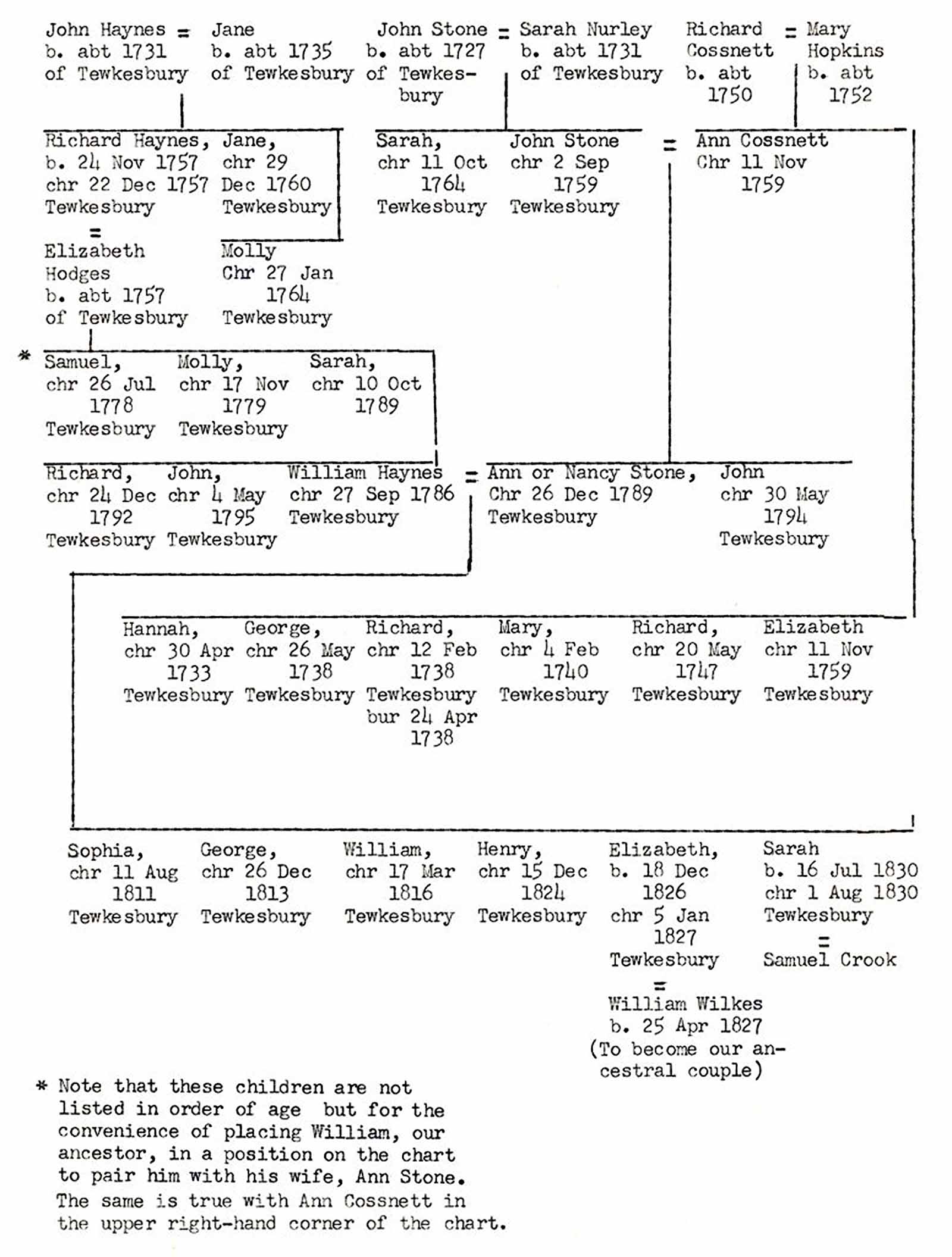At the conclusion of the previous chapter, we saw that our ancestor, John Bradley, whose marriage license classified him as a 'boatman', stopped in Tewkesbury to visit a friend of his own trade, one John Harrison, who claimed Tewkesbury as his home. Whether this town was the end of John Bradley's river route from Broseley of Benthall, his home fifty miles upstream on the Severn River, we don't know. It is very possible that Tewkesbury was an overnight stopover place for John, who may have made it a practice to continue on downstream another ten miles to Gloucester, a port city of twice the population of Tewkesbury, which in turn, was a considerably larger town than was Broseley
As has already been mentioned, John became acquainted with a young lady by the name of Ann Hiatt, and changed his address from Benthall. The second of their three daughters, Elizabeth, christened 27 September 1741, later became our direct-line ancestor, by bringing the Wilkes name into her family. The fact that the christenings of all three of John's and Ann's children appear in the Tewkesbury parish registers, leads us to assume they made their home in Tewkesbury.
We have no way of knowing whether John the 'boatman' or 'waterman' as his occupation was sometimes known by, continued operating his freight-line back and forth between his new home and that of his parent's home in Benthall and Broseley, but we suspect he did. Changing occupations was not a common practice during this period of time, still in the first half of the 1700s. From our standpoint, it was possible for it to have been an interesting occupation, and in as much as John apparently had his own barge or barges, or his own boat or boats before he was married, it is not likely that he would give them up.
Perhaps we, in our modern day, don't fully realize the importance of this occupation. It became very important to the overall commerce of Great Britain, for we must keep in mind that this was prior to the railroad, as we know it today. The steam locomotive was yet to be invented. Undoubtedly, horse-drawn cars on rails plied some areas, but most of the freight transportation was done by water - navigable rivers and canals. Thousands of miles of canals had been made throughout all of England, and especially leading into central England, which became known as the Midlands, which even this early, was becoming industrialized. Cities along the seacoasts, naturally had freight and passenger exchange by small sea-faring vessels.
A few miles from Tewkesbury, up the Avon River which empties into the Severn, light barges and small boats could be handled, but approximately fifteen miles above Tewkesbury, is another important city, Worcester, also on the Severn. But a major navigable canal leads from there into the Midlands to such cities as Birmingham, some thirty miles northeast. From there, to other major centers all over inland England, canals covered almost every locality of any importance.
The canal system of that day was almost a maze on the map, and was far more important to that day than most of us realize. Many men were employed on barges large enough to allow the whole family to make their home on board. This created a problem to researchers of later generations to find family information. Family members could have been born, christened, married, died or buried at different parishes along the canal.
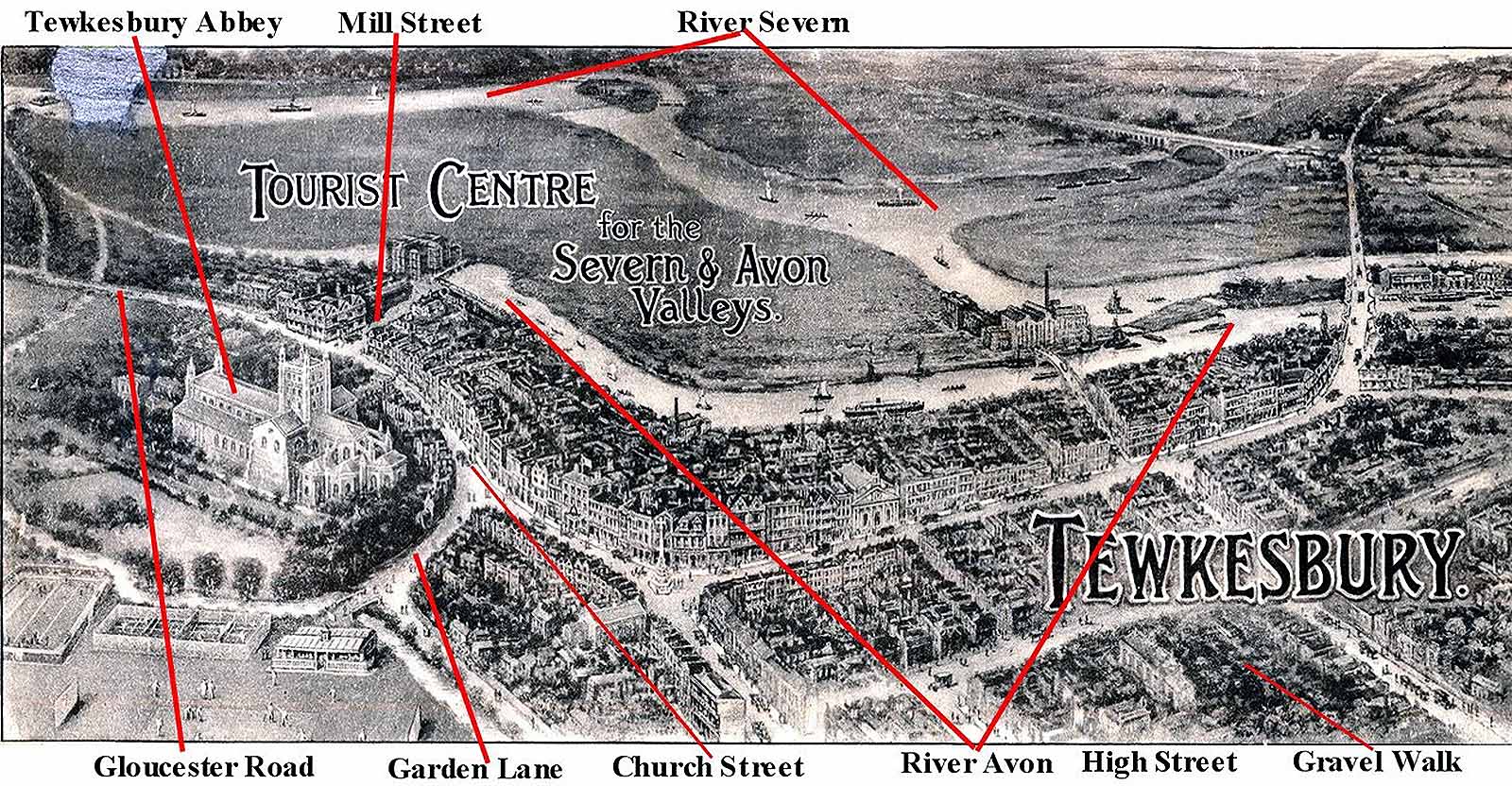
This system of transportation, particularly in England, became outdated in the next couple of centuries by the advent of the faster railroad system. Today, the railroad is becoming outdated by the trucking and bus systems, which in turn is giving way to the modern airways. Just as these more recent conveying systems accommodate both passengers and freight, so too, in its day, did the canal and river systems.
A prime example showing how families were affected by the 'boatmen' or 'watermen' profession, can readily be seen by this example of our own family genealogy. By examining several generations of the most remote on our pedigree chart (see pages 8 and 9) it has been comforting to note that the Cullis, the Bradley, the Taylor and Rowley families - all of our direst ancestry - remained in the area of Broseley or Benthall, two or three miles away, for generations until we come to John the 'boatman' in the middle of the 1700s.
Because of his interest in freighting, he found his wife in Tewkesbury. We have found no evidence that he traveled the canals as many other families did, for as we shall see, the next three or four generations remained close to home - Tewkesbury, but let us not go too far afield - genealogically-wise. Let us see what home life was like in Tewkesbury.
From Lewis' Topographical Guide, which reference was used to obtain a description of Broseley in the previous chapter, we find Tewkesbury to have been, and still is, a market town. The same explanation as was given of the term to Broseley, also applies in Tewkesbury. This town's nearest sizable neighbor down the River Severn and to the south is the larger city of Gloucester (pronounced Glos-ter). As mentioned earlier, the nearest sizable town upstream to the north is Worcester (pronounced Woos-ter). In 1833 when the Topographical Guide was printed, the approximate populations of these three towns were, Tewkesbury - 6,000, Gloucester - 12,000, and Worcester - 18,000. At the time we are discussing when John Bradley was plying the rivers and canals (remember their wedding license in 1738) would have been a hundred years before Lewis' Guide. The towns would not have been as large, but probably in approximately the same proportion to each other. Today's population, 250 years later, would make the towns considerably larger.
Lewis mentions that Tewkesbury is "of great antiquity", and that in 715, a monastery was founded by two brothers, Odo and Dodo, Dukes of Mercia. Its history over the next few centuries was troublesome, and by 1100 AD, the monastery was enlarged and made into an abbey of Benedictine monks. The next few centuries saw much warfare and bloodshed in and about the area. The abbey changed hands two or three times at about the time of Cromwell of whom reference was made in the previous chapter. His government took over the abbey, but it had to be relinquished later to the Royalists in about 1660.
Lewis describes Tewkesbury as a town which "is pleasantly situated in the northern part of the luxuriant vale of Gloucester, and on the eastern bank of the River Avon, near its confluence with the Severn: it is nearly surrounded by the small rivers, Carron and Swilgate, both which fall into the Avon."
The early history of the commercial activities of the community prior to or about the time of John and Ann, and the next couple of descending generations, Lewis will continue to be quoted:
"About the beginning of the fifteenth century, this place seems to have carried on a considerable trade upon the Severn; and a petition was forwarded to the House of Peers, in the reign of Henry VI, stating that the inhabitants had been accustomed "to ship all manner of merchandise down the Severn to Bristol", and complaining of the disorderly conduct of the people of the forest of Dean, who are reported "to have come with great riot and strength, in manner of war, as enemies of a strange country, to stop and plunder their ships as they passed by the coasts near the forest; and that the marauders sometimes not only despoiled them of their merchandise, but destroyed their vessels, and even cast overboard their crews and drowned them." For the redress of these grievances, an act was passed in the same year; and in 1580, Queen Elizabeth made Tewkesbury an independent port, for the loading and discharging of ships with merchandise to and from the parts beyond the seas, which grant was afterwards revoked, on a petition from the inhabitants of Bristol.
See a map showing the Wilkes places area here.
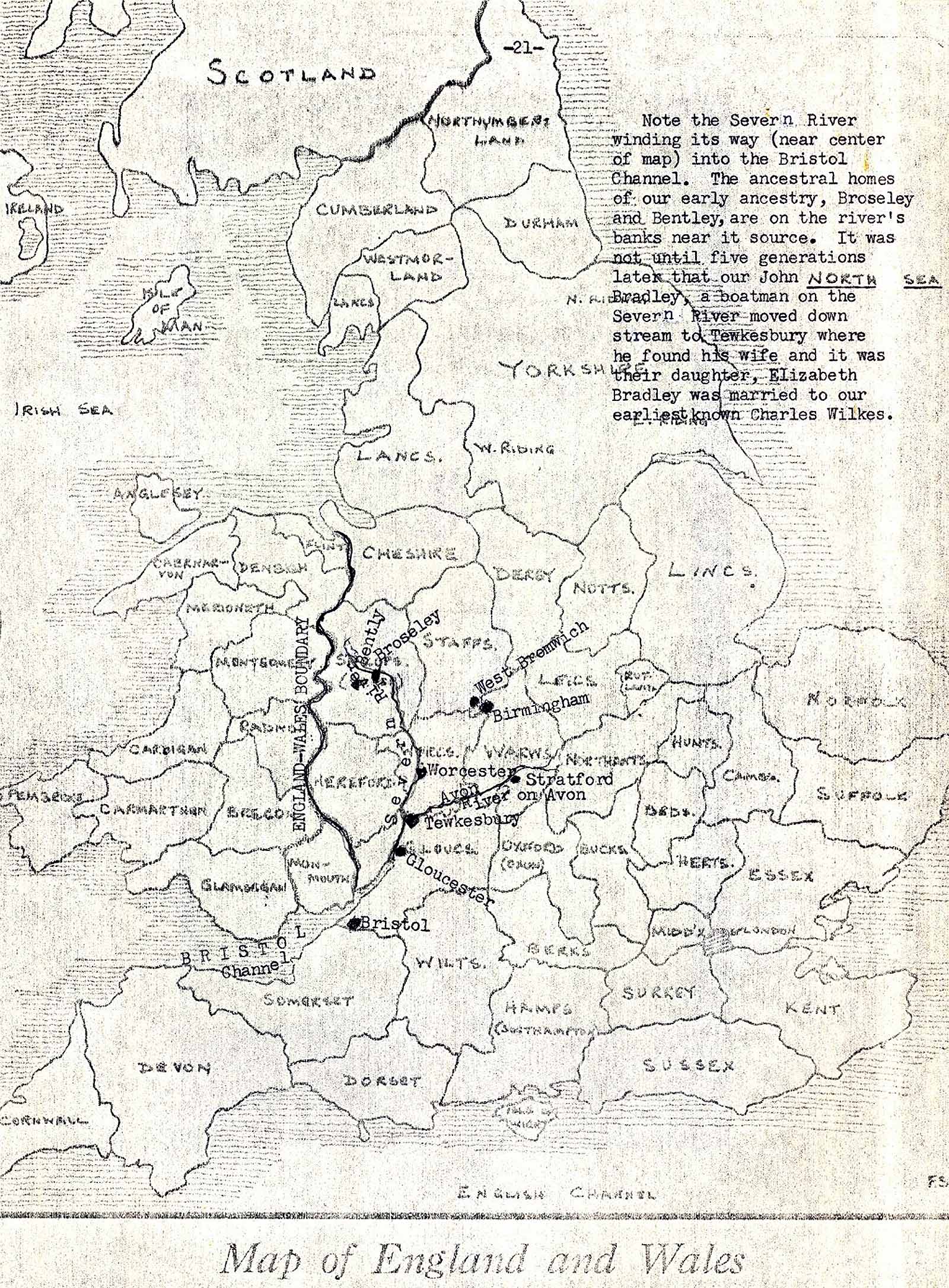
"Tewkesbury formerly enjoyed a considerable trade in woolen cloth, and was celebrated for the manufacture of mustard of superior quality; the principal branch of trade at present (1833) is the stocking frame-work knitting, which was introduced about the commencement of the eighteenth century, and in which from 700 to 800 frames are at work, employing about 1500 persons. The manufacture of cotton-thread lace was established at Oldbury in 1825; a considerable trade is carried on in malt, and some in leather, and there is a large manufacture of nails. An extensive distillery and rectifying establishment were opened in 1770. The former has been abandoned, but the latter is still conducted on an advantageous scale. A very considerable carrying trade (freight) centers here, in connection with the Avon and the Severn, goods being conveyed by land and water to all parts of the kingdom; on the bank of the Avon are extensive corn-mills, formerly belonging to the abbey. (corn is a term used in England, even to this day, which applies to small grains of all kind, such as wheat, barley, oats, etc. and does not apply to Indian corn as we know it in the states. LB) The market days are Wednesday and Saturday; the former for corn, sheep and pigs, the latter for poultry and provisions. There are great cattle markets on the second Wednesday in June, August, and December.
"Tewkesbury, though a borough by prescription (equivalent to a U.S. city) was first incorporated in 1574 by Elizabeth."
This writer cannot help but testify to the beauty of the countryside in and around Tewkesbury. At the conclusion of my mission in February or 1930, I spent a day visiting the Tewkesbury area with the intent of seeing the general area of the home of my Wilkes' ancestry, and sense the very atmosphere my ancestors knew and partook of. They were there from the time the Wilkes left their home in Tewkesbury in April of 1855, back to our earliest known progenitor, Charles Wilkes, who was born about 1740, who married his wife on the 15th of January 1765, and from then, on back to her father, John Bradley who came down the River Severn to marry her mother, Ann. Both of them declared their respective age at the time of their marriage license to be twenty one years, this on the 12th of May 1738.
It is most difficult to describe one's sensitivity as he walks the very paths and streets and churchyard his grandfather walked as a child, or the same places his great-grandparents also walked. To stand at the same door which led them into that great majestic Tewkesbury abbey where they were sprinkled as babies in the baptismal rites of the Church of England, not only their generation, but the generation prior to my great-grand-parents, and even to the generation prior to that, and still the preceding generation. Perhaps I am overly sensitive to such experiences, but as stood there alone, many miles from anyone I knew, tears welled into my eyes which I was not ashamed to let drop from my cheeks unchecked. There was no one to witness that experience excepting, perhaps, it may have been those of my family who were already, and had been for many years, buried beneath the very sod on which I was standing.
Not far from the path leading to the front door of this old - very old-abbey, I had no difficulty finding a moderately sizable tombstone, which was commencing to show its age. One only has to go into those centuries-old grave yards in England to discover that tombstones, as well as we humans, show age. While the larger lettering was readable, it was necessary to take my knife to scratch the old and the newer moss from the inscriptions.
Throughout the centuries in England, it has been the practice to bury more than one person in a grave - the first to the bottom, the next just above, the third above that until, perhaps, as many as six in a single grave. The particular headstone I had located, when scraped and brushed off, showed that the grave contained the bodies of three persons, namely, and these are the exact extractions I am this day (1984) copying from the notebook I copied into on the 3rd day of February 1930: WILLIAM WILKES, died Feb. 23 1886, age 83; also of ELIZABETH, wife of the above, died Dec 18th 1885, age 84; and of MARY A. WILKES, their dau., died March 18, 1886, age 54. Thus, the full inscription of my 2nd great grandparents' headstone. There were other stones, which I copied, which appeared to be of the family, which I shall not include at this point.
After spending some time in the cemetery, the sexton arrived, who showed me the inside of the abbey, and spent time with me searching for additional Wilkes' headstones. I was particularly interested in locating some of a previous generation to William's, but we were not successful. Eventually, these earlier generations were located by correspondence through the Genealogical Society. The fact that headstones do not presently exist, does by no means, indicate a certain person was not buried in that cemetery. Certainly all the dead did not have markers, and even if they once did, after a century or two, oft times no living family remains to take care of the stones, and often the markers are broken or are knocked over and hauled away. The graves still remain, but cannot be found to whom they may belong.
Subsequent research work has revealed that our William Wilkes of the above headstone, was the son of Charles Wilkes and Elizabeth Bradley. This last Charles has become our earliest known ancestor carrying the name of Wilkes, and it is his name mentioned at the conclusion of the previous chapter.
All sources of wills in the Tewkesbury area have been searched, but each and every Charles Wilkes comes up negative so far as our Charles is concerned. The German air force in World War II bombed England's government buildings which held public records such as wills and probates, and many such records were destroyed. Whether any of the older Wilkes' records were affected, we perhaps, shall never know.
Two Charles Wilkes' wills, which were copied by the researchers, are at hand, with neither of them of value to us, however, the earlier of the two could possibly have to do with the parents, however, only the wife is listed in the will. The will was dated the 19th of December 1739, and was proved on the 7th of February, 1739/40.
During this period of time England and most of Europe used the Julian Calendar, where March 25 was the first day of the new year. In 1752, they changed to the Gregorian Calendar where the first day of the year was January 1. So the will was proved on 7 February 1739 according to the Julian Calendar which was in use at that time.
As stated, the above will could possibly have been that of our known Charles' parents. We have no way of knowing from the data it contains. It has been mentioned for two purposes: first to verify the fact that this type of record (wills) has been searched, and secondly, it contains an item of interest as to one occupation one Wilkes family was following. This will tells us this Charles was a 'whip maker'.
The second will for a Charles Wilkes was dated about a generation later than the previous one - 1768 - in the Beckford Parish six miles from Tewkesbury. The date of probate does not allow for him to be our Charles, nor are the names of his family agreeable to our family. Of interest in this will, was his occupation. He was a farmer. These two wills show that in the Tewkesbury area, one and more generations later, just as in the Shropshire families, there was a great variety of occupations to be had.
Let us examine a little more closely, our Charles and Elizabeth Bradley Wilkes. As already noted, their marriage occurred on the 15th of January 1765 in Tewkesbury. Their first son, our direct progenitor, Charles, was christened on the 28th of July 1765, also in Tewkesbury.
No additional christenings have been located of other children to this couple, Charles Wilkes and Elizabeth Bradley, but quite true to most other families. Experiences of this period of time, there were deaths recorded. It has been determined by genealogists, that approximately 50% of all children were taken to the cemetery before they reached two or three years of age. Unless there were additional children of which we have found no record, Charles and Elizabeth out-did this high percentage. The parish record shows that son, George, was buried on the 9th of Dec 1767, and five entries later in the same parish record, a second boy, also named George, was buried on the 22nd Sep 1775, both the sons of Charles and Elizabeth.
The reader's attention is called to the fact that in 1978, a subsequent branch of the Wilkes family, hired a professional researcher to extend the family lines. So far as can be determined from our reviewing his report, he confined his work to materials already in the Salt Lake Genealogical Library, including the archives which contain family group sheet records of such submissions to that library through the years from members of the Church. Also, data was obtained from the Computer File Index, etc., etc.
In this researcher's report, he states he discovered from the above mentioned sources, that the common ancestors, Charles Wilkes and Elizabeth Bradley had three sons, Charles, who survived and became ancestral, and "sons John (buried 26 June 1770) and George (buried 22 Sep 1775), so apparently Charles and Elizabeth had other children although their baptisms were not found."
The reader will note that this researcher agrees only in part with our findings of the family of Charles and Elizabeth, this is that son, Charles, was christened 28 July 1765, and that there were two burials from the family, however, he names a son, John, having been buried on the 26th June 1770, which son we have not located. Instead, our records show a son, George, not on the date he gives for John, but rather on the 9th of Dec. 1767. Our records are in agreement with the last burial from the family, George, buried 22 Sep 1775.
Let it be clearly understood that we are not disputing, in the least, that there could have been a son, John. This is entirely possible for there is no date conflict showing up. From the nature of this newly reported date, it would indicate that it would originally have had to have come from the parish record. On the 7th of October 1955, the Salt Lake Genealogical Library received from our professional researcher in England, a copy of all marriage, christening and burial entries from the Tewkesbury parish records which applied to all of our ancestral lines - Wilkes and Bradleys -between the dates of 26 Jan 1709 and 2 July 1779. This copy of parish transcripts was subsequently mailed to this writer, and at the moment of this typing, is at hand for closer scrutiny. No burial entry is included in the Tewkesbury parish for a John, buried in 1770, nor is the name found in the parish records of ten additional parishes neighboring Tewkesbury, which are included with the afore mentioned copy of transcripts.
Admittedly, the burial of another child from the family of Charles and Elizabeth does not alter our line of ancestry, however, if such a child belongs to them, we should show concern. On the family chart, which will be prepared shortly, John's name will be included with the other three children, however, due to the fact of the circumstances being as they are, we shall take the liberty of adding a question mark to indicate that we haven't fully found documentation sufficient to, altogether satisfy us.
What is true of this particular generation, so far as possibilities of there being additional children, also holds true with all generations. Attempts are made to confirm the fact that the children shown on the family group sheets actually belong there, but the possibilities for others are not discounted.
We have discovered nothing relating to the occupations of these generations of the Wilkes families. Charles, the only known surviving son of Charles Wilkes and Elizabeth Bradley, grew to adulthood and married Jane Sysom. In an early report from our English researcher, he reported the name as Jane Lysom, however, at a subsequent search, the next researcher discovered the spelling to have been Sysom. This marriage occurred on the 26th of August 1791 at Tewkesbury.
Their first child, a little girl, Mary, was christened on the 23rd of July 1793 in Tewkesbury. The parish register announces the burial of Mary, the daughter of Charles and Jane Wilkes on 24, Sep 1797. We have found no direct evidence of there having been born to these parents other children, however, it is very possible. The parish register tells us that wife, Jane, was buried on the 3rd of Aug 1802 at Tewkesbury. During these years, when young mothers die, it can usually be attributed to childbirth, however, we have no grounds for such an assumption in this instance. Neither is there evidence that husband, Charles, was left with small children upon his wife's deceasing. The possibility of a little boy is about to show up.
Charles was twenty-six years of age when he married Jane, and at the time of his wife's passing, he was thirty-seven years old.
It so happened, also in Tewkesbury, there was a young widow, a Mrs. Mayall, who had married at Tewkesbury in 1791, the same year our Charles and Jane had married. Mrs. Mayall had been christened on the 1st of September 1771, therefore was in the neighborhood of being six years younger than Charles. We must keep in mind we are dealing with christening dates, rather than actual birth dates. Christenings were usually within days or a few weeks, there were instances where the christening was much later. Her christening had taken place in Bushley, a small parish of three hundred people, which was located about two miles from Tewkesbury. It is not at all impossible that these two young couples were acquainted with each other at the time of their respective marriages. While Tewkesbury wasn't that small, it wasn't that large either --a population of about 5,000 people. Nevertheless, whether they were acquainted or not, Charles and Mrs. Mayall later became acquainted and he as a widower, and she as a widow, were married 26 Dec 1804 at Tewkesbury.
The information we have at hand concerning Mrs. Mayall - additional research has shown her maiden name to have been Ann King - does not reveal how long she had been a widow, but an interesting situation has developed. When Charles and his new wife, Mrs. Ann King Mayall, started housekeeping together, there shows up on their family group sheet, a little boy, who was a little over two years of age. Two or three possibilities immediately surface. The parish register of Oct 11,1802, shows the christening of "Charles, spurious son of Anne Mayall". Our professional researcher, through the then Genealogical Society, naturally assigned him to his mother following her second marriage to Charles Wilkes, and assigned him his surname as Wilkes. There is no inference that Charles was or was not his father.
Another possibility is that the little boy, Charles, was very much Mrs. Mayall's son by Ashley Mayall, her first husband. Husband, Mr. Mayall's death date has not been located.
And the third possibility-the little two year old son Charles, could have been the legitimate son of Charles and Jane Sysom Wilkes. Death of a mother in childbirth was not at all an unusual thing during these years. Jane was buried on the 3rd of August 1802. If the child was born and lived despite the death of his mother, he would have been taken care of by his grandmother, Elizabeth Bradley Wilkes, who was then approximately sixty years of age. Her husband, Charles had died in 1777. The little boy was christened two months following Jane's death. If she were his mother, a two month delay in Charles, the father, having him christened, would not be unusual, particularly under these supposed conditions. Charles, the supposed father, could have moved back with the supposed little son, to live with his mother for the two years, and when he and Mrs. Mayall were married, a new home was provided.
No record has been found of Mrs. Ann King Mayall having other children under the Mayall name. The Tewkesbury parish register, as stated earlier, gives the marriage date of Charles Wilkes and Ann Mayall as the 26th of Dec. 1804, and subsequently, the christening of William, son of Charles and Ann Wilkes 4 June 1805. This William became the today's (1984) Wilkes' ancestor. The same parish register reveals the christening of "John, son of Charles and Ann Wilkes, 21 Sep 1808.
There is a burial entry in the Tewkesbury register of Elizabeth Wilkes, 31 July 1803, which undoubtedly, was Elizabeth Bradley Wilkes, the grandmother of the previous couple of paragraphs, which death date probably shows there to have been an error in pre-supposing she could have cared for her possible little grandson until the marriage of Charles and Mrs. Mayall.
Life is replete with disappointments - more for some than others. This lady, our direct progenitor, Ann King Mayall, and Charles had our direct progenitor, William, as stated above, in 1805. The parish register reports the sad news that husband, Charles, was buried 30 July 1808, two months prior to the birth of another little son whom Ann named John, thus the recent marriage of Charles Wilkes and Ann King Mayall of the 26th of Dec 1804, came to an end by death of Charles in 1808. This marriage was a short one of less than four years. As can be noted, our ancestor William Wilkes, was but 3 1/2 years of age when his father passed away. His mother, Ann King Wilkes had the full responsibility of raising her three children.
Despite the fact that this was Ann's second marriage, the Genealogical Society (1947) suggested this family be sealed together, which was done.
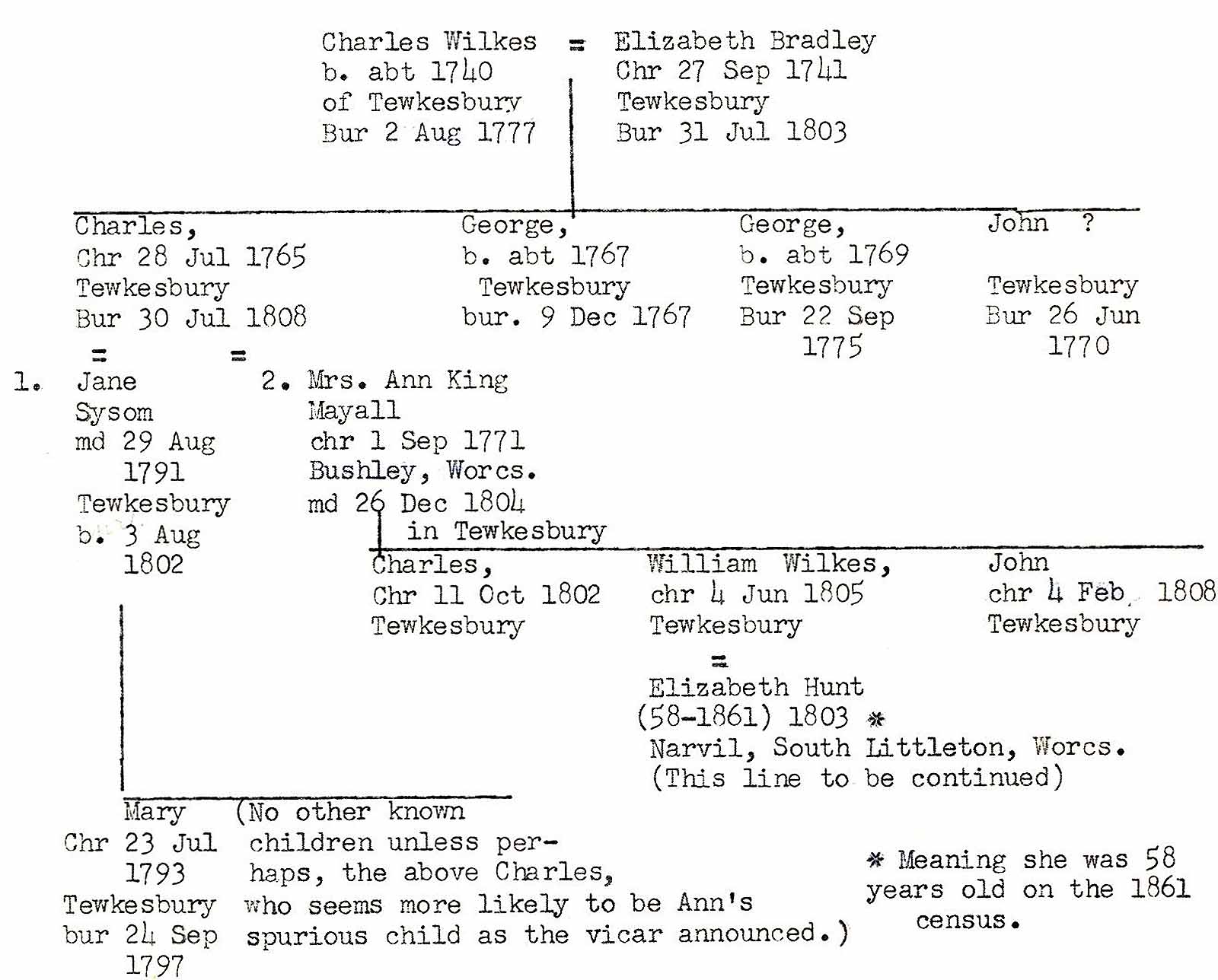
With the marriage of Charles to his second wife, Ann King Mayall, through whom our ancestry courses, through their son, William Wilkes, we introduce another line of ancestry, the King line. As stated earlier, Ann King was christened 1 Sep 1771, at Bushley, a small parish two miles west and slightly to the north of Tewkesbury. Actually, the little parish of Bushley antedates the parish at Tewkesbury so far as the commencement of their respective parish records are concerned. This is not to imply that Bushley is historically older than Tewkesbury, for this very likely would not be true. As earlier indicated, Tewkesbury is very ancient, but Bushley cannot be considered a modern suburb. Its earliest parish records are dated as of 1538, whereas Tewkesbury's earliest parish record begins in 1559.
Bushley , with its little over 300 population in 1833, has to have been considered very much rural, and it would not seem unlikely that these folk - most of them at least - would have been agriculturists, maybe associated with the raising of vegetables for the market days of their near-by neighbors, or perhaps they were in a phase of livestock raising. There is room for speculation on this subject.
Ann King was the eldest of four known children, three girls and a boy, all christened within the decade of the 1700s. The four of them were christened in the Bushley parish. Their parents, William King and Mary Barton, were not christened there, nor seemingly no known progenitors were there prior to this particular generation. The parish register was searched from 1538 to and including 1812. The Genealogical Society, in a letter dated 8 January 1960, reported that another twenty-five parishes in the area were searched for the period 1739 to 1753. A christening of a Mary Barton was found in 1753 at Mathon, Worcestershire, a small parish with a population of fewer than 700 people, some twelve miles north and west of Tewkesbury. Her parents, William Barton and Hannah Walker, were married at Leigh, approximately ten miles north and east of Tewkesbury. While the Society felt these to be ancestral, they suggested that they be put on "hold" for further documentation. Throughout the years since, nothing more likely has developed. With this caution to be kept in mind, Ann King's probable parents and a set of probable grandparents will be charted. (Please keep in mind Ann's grandparents and her mother's chr. date and place are not proven.)
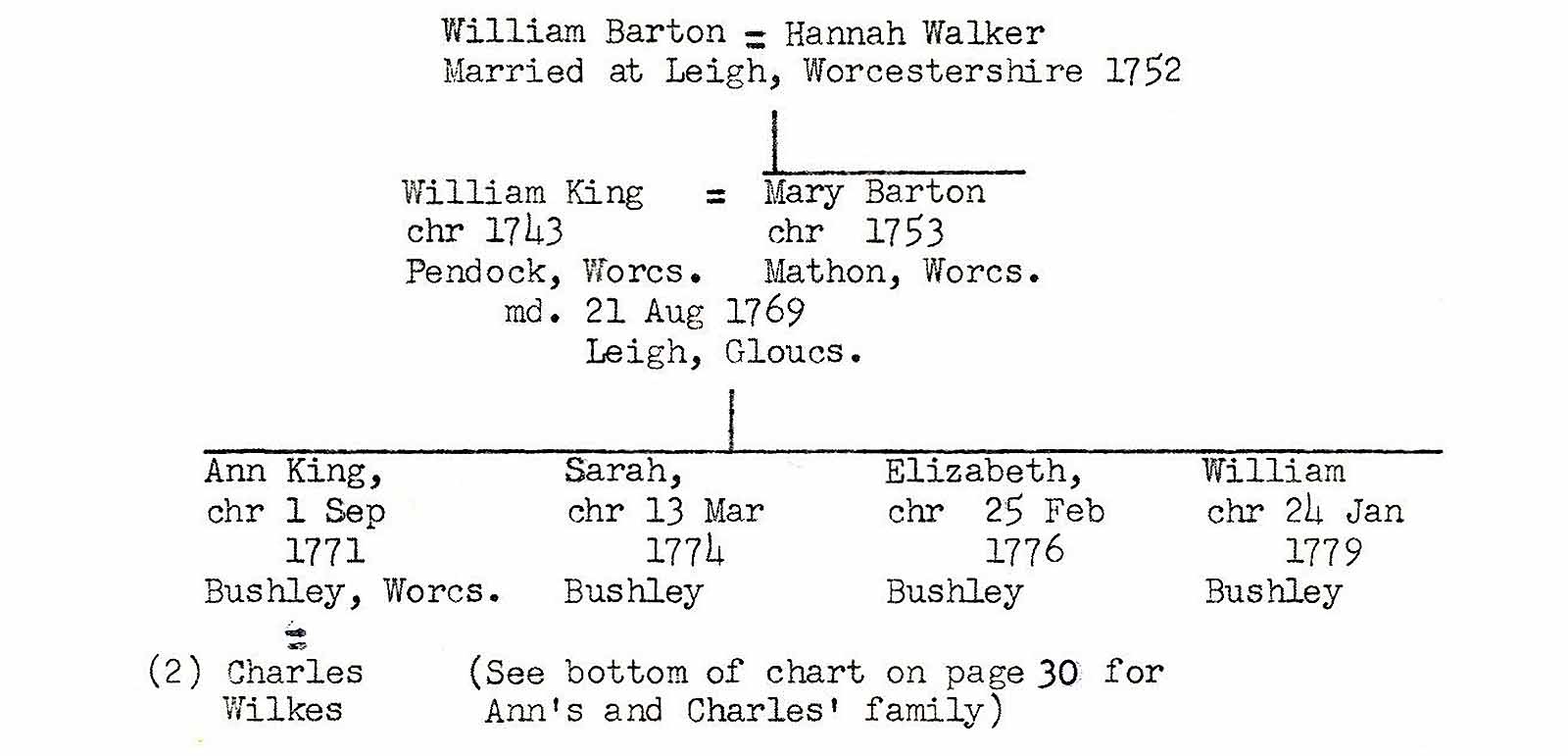 Chart 2: See the bottom of chart 1 for Ann's and Charles' family
Chart 2: See the bottom of chart 1 for Ann's and Charles' family
At this point in our story, we enter into a subsequent generation, with the marriage of William Wilkes and Elizabeth Hunt, as charted on chart 1.
Without fail, each generation brings its own challenge, and this on-coming generation in our research is not an exception.
As indicated earlier, young William Wilkes, one of the three sons of Charles and Ann King Wilkes, and who was to become a direct ancestor, lost his father in death, when he was three years old. When father, Charles, passed away, he left his widow, Ann, a relatively young woman of thirty-seven or thirty-eight years of age, with son Charles, five years of age, William, as stated, three, and baby John, five months old. In any period of time such circumstances are very trying. Ann appeared to have had her share of disappointments, for her first marriage to Ashley Mayall resulted in her becoming a widow. An attempt was made to find his records, but to no avail. His death nor burial dates have not surfaced in our research. In such circumstances, one is left to wonder whether, perhaps, he became disappointed with his marriage and voluntarily left for parts unknown, never to return. In such cases, after the wife has been left alone for two or three years, and not knowing whether her husband is alive or dead, she could be declared a widow.
We want to also recall that the area of Tewkesbury was considered an inland seaport, for smaller boats could move up the River Severn from Gloucester to Tewkesbury, and from there with barges. As has already been brought to our attention, employment on the water required a great number of men. There would be long absences on sea-going vessels as they traveled up and down and around the coasts of England, as well as much freight traffic across the Atlantic to England's colonies, and boat traffic to the western European countries and into the Mediterranean area, in fact, all over the world. Much of this type of employment was fraught with danger for small boats, and storms at sea often engaged in conflicts with the boat and her crew becoming victims. One does not have to extend his imagination far, to see many other possibilities or exigencies relative to the hazards of employment of the families of our ancestors during the years of the early 1800s.
Ann King was still sufficiently young that she could have remarried, but searches of the marriage records of the nearby parishes, including Tewkesbury, proved fruitless in this resort. Also, burial transcripts for Tewkesbury were searched up to 1850 for Ann's burial, but she was not found.
As stated earlier, her son, William, was christened on the 4th of June 1805. He grew to young manhood and married reasonable early - eighteen or nineteen years of age, to a young lady a year or two older than he, Elizabeth Hunt. One record shows her as Martha Elizabeth, but she apparently was known by Elizabeth, for that is the name the census takers used many years later. We are just after the turn of the centuries, at the time of this marriage, and while England had started with census taking, these early census records are of no value for research purposes. An improvement was made in their 1841 census, and is of limited value to researchers, but it was not until the 1851 census of England, that a real helpful census was taken.
No christening record has been found of Elizabeth Hunt. The parish entry of their marriage, as entries regularly are, was simply a statement of fact, such as "25 Dec 1823, William Wilkes and Elizabeth Hunt married". Locating the parish of her birth proved a real challenge for several years. In the mean-time, the 1841 census showed that she was not born in Gloucestershire. One of the peculiarities of that census was that the census taker showed only a "yes" or "no" as to whether the individual was born in the county where the census was being taken. Her answer to that question was a "no".
The 1851 census showed the following, which was more specific than the 1841 census, at least so far as birth place was concerned:

Prior to the searching of the 1851 census shown above, we had already become aware of five additional children, and naturally wondered why they didn't appear on this census with the rest of the family. Eldest daughter, Hannah, would have then been twenty-six years of age, and undoubtedly had married. Son, William, our progenitor, had married in 1846 at Tewkesbury. These two would have had homes of their own. Next daughter, Mary Ann, twenty-one was at home. Where were the next three girls, Elizabeth, nineteen, Sarah, sixteen, and Eliza, thirteen? The census taker listed only the ones who were at home at the time. It is quite possible Elizabeth had already married, or as many young girls did at that age, could have found employment in another home, or in a business too far away for a trip to be made home each night.
But, to return to our concern with wife Elizabeth's birthplace. Seemingly, the census solved the problem, for it said she was born at Norvil in the neighboring county, Worcestershire.
While the place was now known, it compounded our problem, for no such place as Norvil could be found on any map, nor any known record. Inquiries were made at many post offices, but no help came. Could the census taker have misunderstood Elizabeth and put the wrong name down? Other questions came to mind. The researcher pondered over it, and the question came to his name as to what Elizabeth may have told the next census taker ten years later? The next concern was, would the family be in Tewkesbury after another ten years, and would there be a chance that Elizabeth would no longer be alive?
The search was made, and the family was again located, but this time much abbreviated:
 The 1861 Census
The 1861 Census
The lady we were looking for, ten years later, reported the same place of her birth, this time with a different spelling, which undoubtedly was due to the census taker, but near enough that there could be no question but that it was the same place she earlier reported her birth to have been.
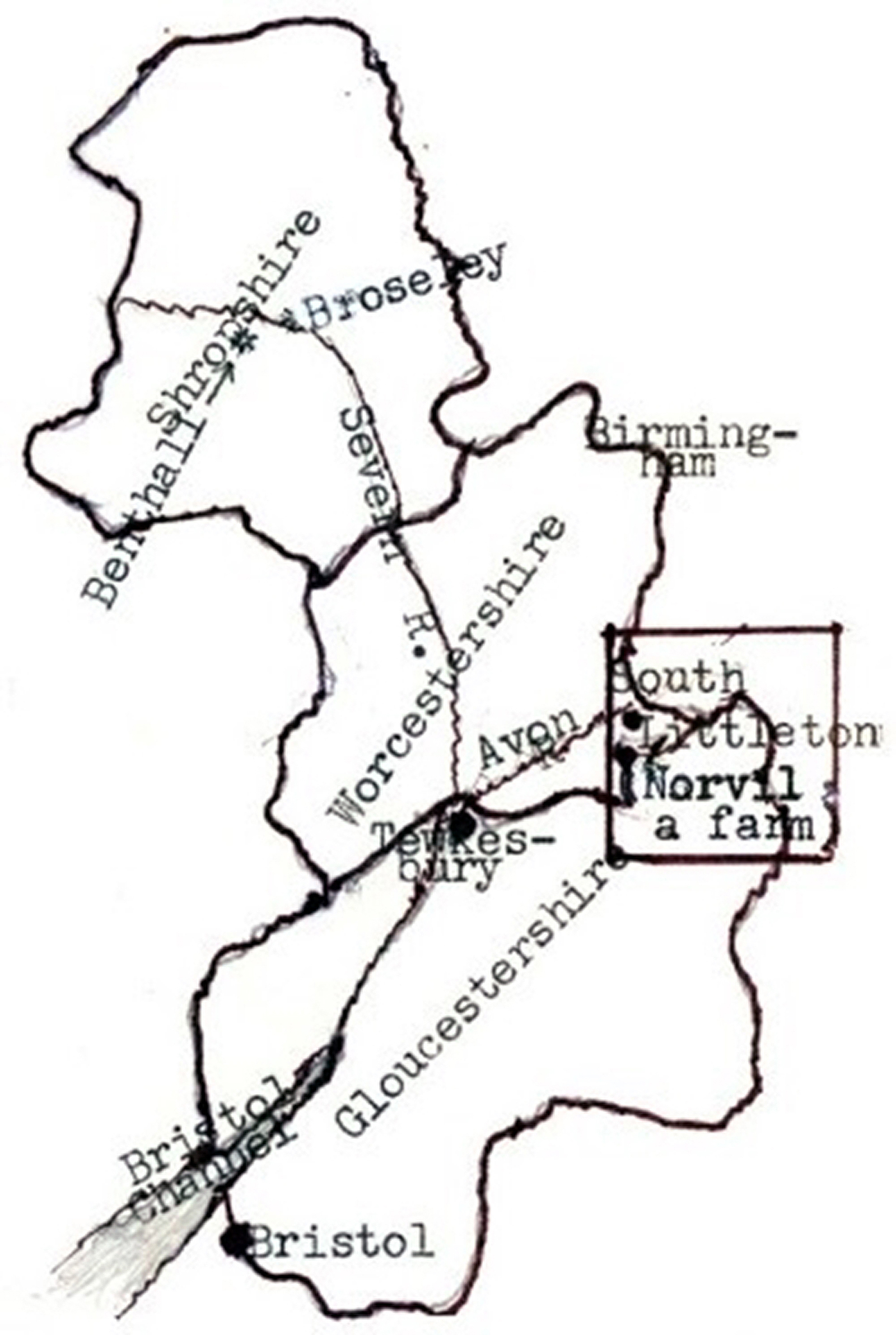
As a result of the second census, one of our concerns had been solved, that is, this time her earlier statement as to her birthplace was confirmed. Now there seemed to be but little question but that it was a place in the neighboring county, called Norvil or Narvell. The second concern had not been solved - where in Worcestershire? Post offices were again consulted after this lapse of ten years. There was no post office there now, anymore than there had not been one a decade earlier. Again, old postal guides were resorted to, for perhaps there had been such a place a half century or more ago, and it no longer warranted a post office since then. There was simply no indication that such a post office ever existed. The parish ministers in both Gloucestershire as well as in Worcestershire (Gloster and Wooster, respectively) were again contacted as they were ten years earlier. Their replies this time were the same, "No such place is known."
It was regrettable Elizabeth Hunt Wilkes was not alive in the 1960s when our concern was paramount, and we were seeking a solution, but she wasn't. Over thirty years before, I had scraped the moss from the inscription on the tombstone. She had already been resting there over forty-five years, so there was simply no way that she would be of any help in telling us where Norvil was at the time of her birth in 1803. Too, maybe she didn't know. There remains the possibility that she was aware where she was born only from hearing the name of the place from her parents. They could have moved when she was but a baby, but this type of speculation had nothing to do with the problem.
It seemed we were up against a brick wall. The professional researchers in England said we were at a dead-end until the place of either Norvil or Narvel could be found. Frank Smith agreed that in order to extend her line, her christening record had to be located, which would give us the name of her parents. The only hope of locating her parents was through her records, either birth or christening.
Every effort had been expended, however, our researcher in England - and this was over a period of years - when he was in the area, had this problem in the back of his mind and was constantly on the look-out for a little place known as Norvil, supposedly somewhere in Worcestershire.
On the 24th of February 1965, a letter was written by the Genealogical Society over the signature of Frank Smith, that they had just received work from the English researcher. He had been in a public library that had an old map showing a farm called Narvil, in the parish of South Littleton in Worcestershire. "The registers of this and all adjoining parishes have been searched, but no likely christening has been found. We have now arranged to make searches in all of the nonconformist chapels with a given area to see if she was christened there."
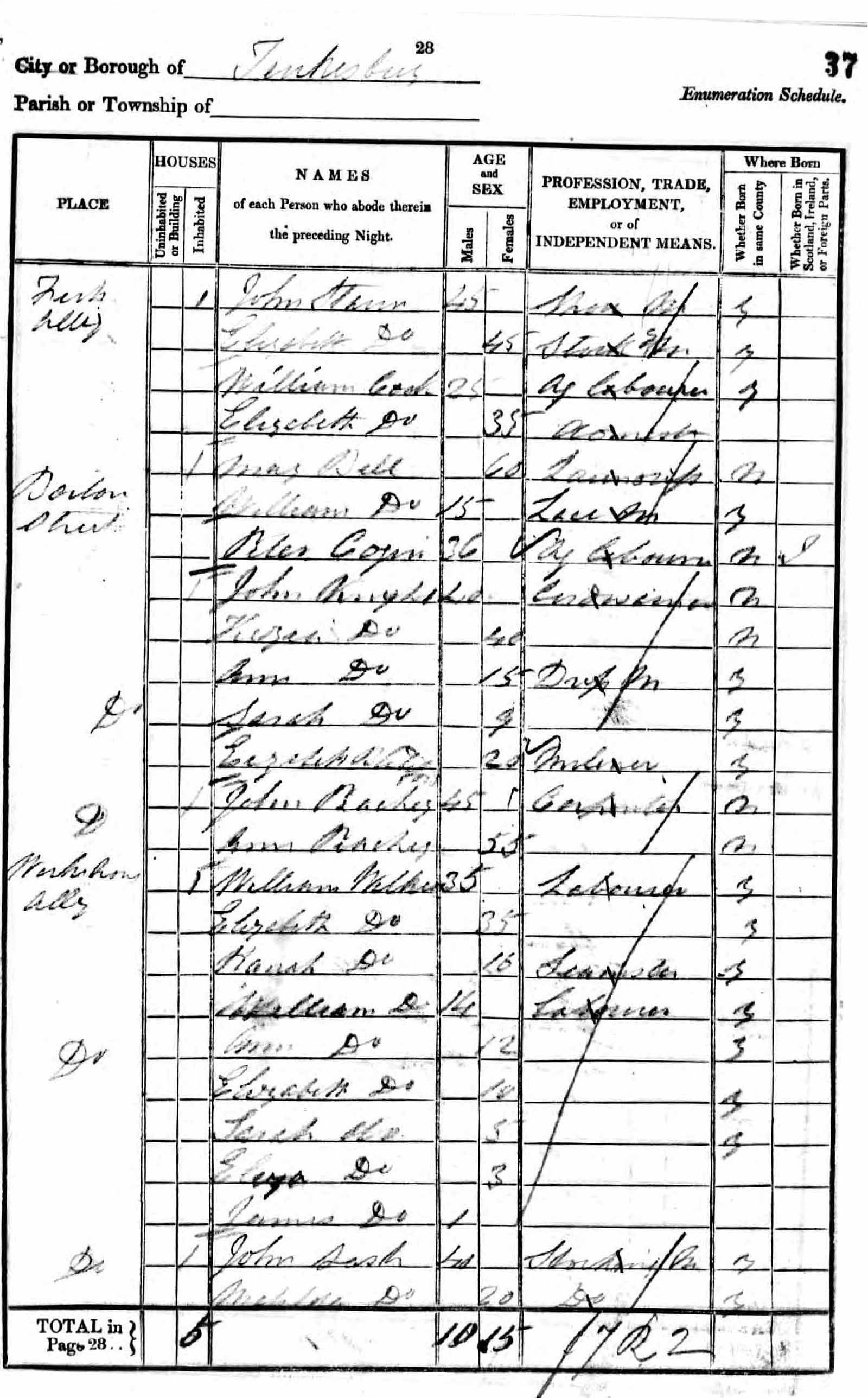
What a find, which resulted in another disappointment! A search lasting for more than ten years, to end with the fact that the name was the name of a farm! It shows that one doesn't even have to find the name of an ancestor to enjoy a thrill. A long-standing problem was solved, and it was all so understandable!
Since my father was not able to find a christening for Elizabeth, the place of her birth is hard to determine. I believe that he was mistaken about her birth location in the 1841 census. The 16th line in the image to the right shows the entry for her in the 1841 Tewkesbury, Gloucestershire census. One of the questions asked each person was "Whether born in the same county". The enumerator wrote y and n almost the same. It looks to me that she answered "yes".
The list below shows the birth place that she gave for each census from 1841 to 1881.
- 1841: yes she born in the county
- 1851: Worcestershire, Norvil
- 1861: Narvell, Worcestershire
- 1871: Tewkesbury, Gloucestershire
- 1881: Tewkesbury, Gloucestershire.
An Elizabeth Hunt was christened in Kingham, Oxfordshire on 3 October 1802. Kingham is about 15 miles southeast of Tewkesbury while Narvel is about 15 miles northeast. Our Elizabeth Hunt's confusing statements made on censuses throughout her life, claims she was either born in Gloucestershire or Worcestershire, but never in Oxfordshire.
Ruth Blacker Waite
And, another fruit of the search resulted from the census: William was a "mason's laborer". At least we have learned this particular generation's occupation. He was in the building trade, as could quite possibly have been the same for the generation before. For two reasons brick and stone were extensively used in the construction of homes and other buildings in England -- first, the lack of timber in that country, and second, the damp climate. Even shingling of roofs was with slate shingles - hand made - all of which provided employment. And, as we use the term employment, it doesn't necessarily mean one was employed by others. Many small businesses were of a private nature operated by a single individual or by a family. Father-son teams were practical and successful. We wonder if such were the nature of William's and perhaps, his father, Charles, before him.
Notice the life-span of this couple. The shortness of William's father's life, was made up for in the case of William, who reached the ripe old age of eighty-one years. Elizabeth, who died two months prior to her husband, reached eighty-two years of age. They were both buried in Tewkesbury, and it was their headstone to which the writer referred in the previous chapter, as having visited and copied the inscription in his visit to Tewkesbury in 1930. Elsewhere in this history, one will find a picture of the couple as well as that of their headstone.
William and Elizabeth were the parents of a relatively large family, as will be noted on their family chart shown below. Their oldest daughter, Hannah, was born in Boddington, four or five miles east of Tewkesbury, which was a small parish of about four hundred inhabitants at that time. The rest of their children were christened in Tewkesbury. Their second child and first son, was named after his father, another William. He was to become our ancestor, and will have the distinction of becoming the first of our Wilkes family to immigrate to the U.S.
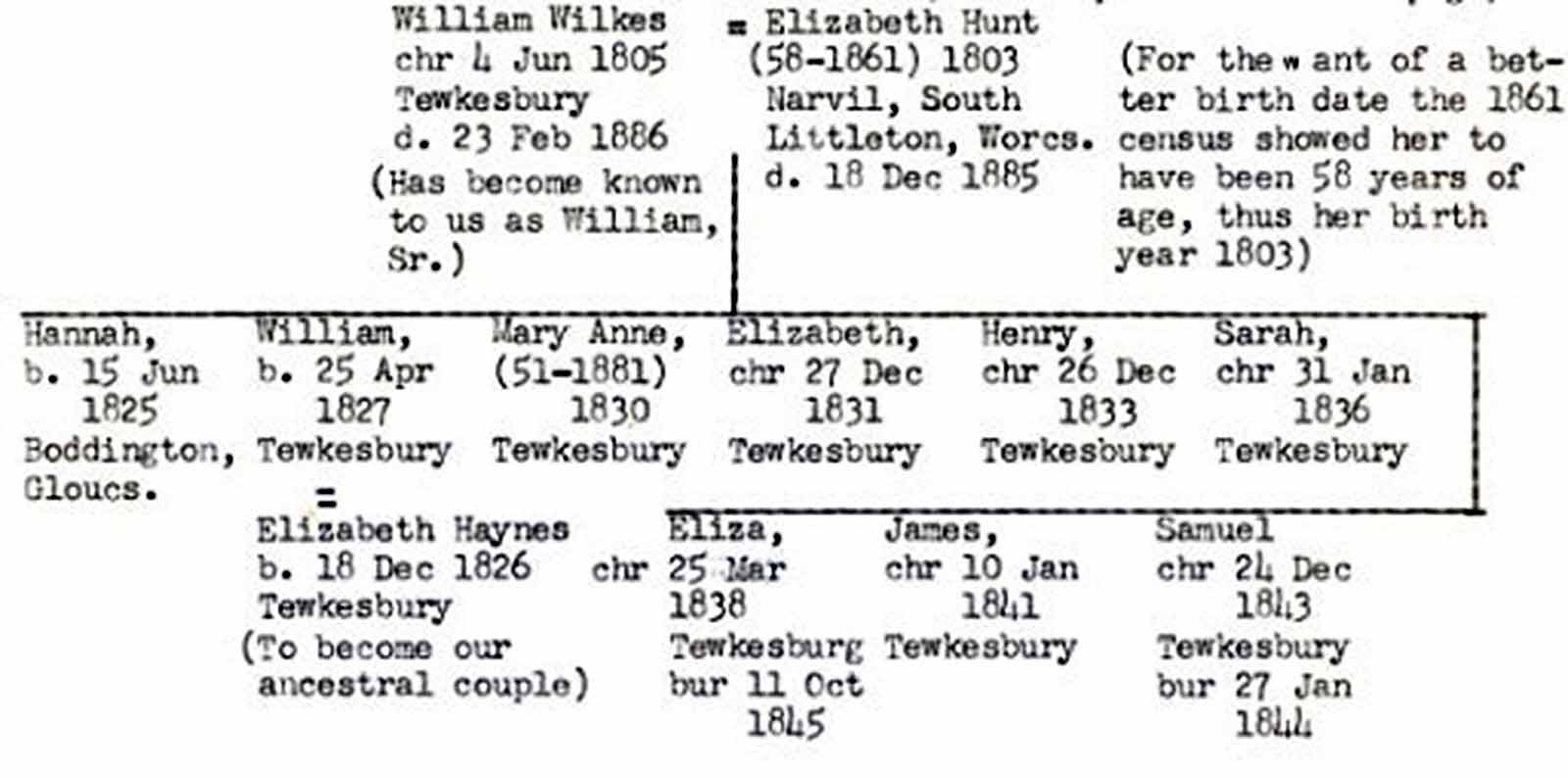 Chart 3 - William Wilkes and Elizabeth Hunt Wilkes family.
Chart 3 - William Wilkes and Elizabeth Hunt Wilkes family.
When my father created Chart 3 shown above, he did not have all of the correct information. The name of the seventh child is not Eliza but Helen. The christening and burial records list her as Helen, but for some reason she is listed as Eliza in the 1841 census. Also a daughter called Harriet was born after Samuel. She lived just three years.
Ruth Blacker Waite
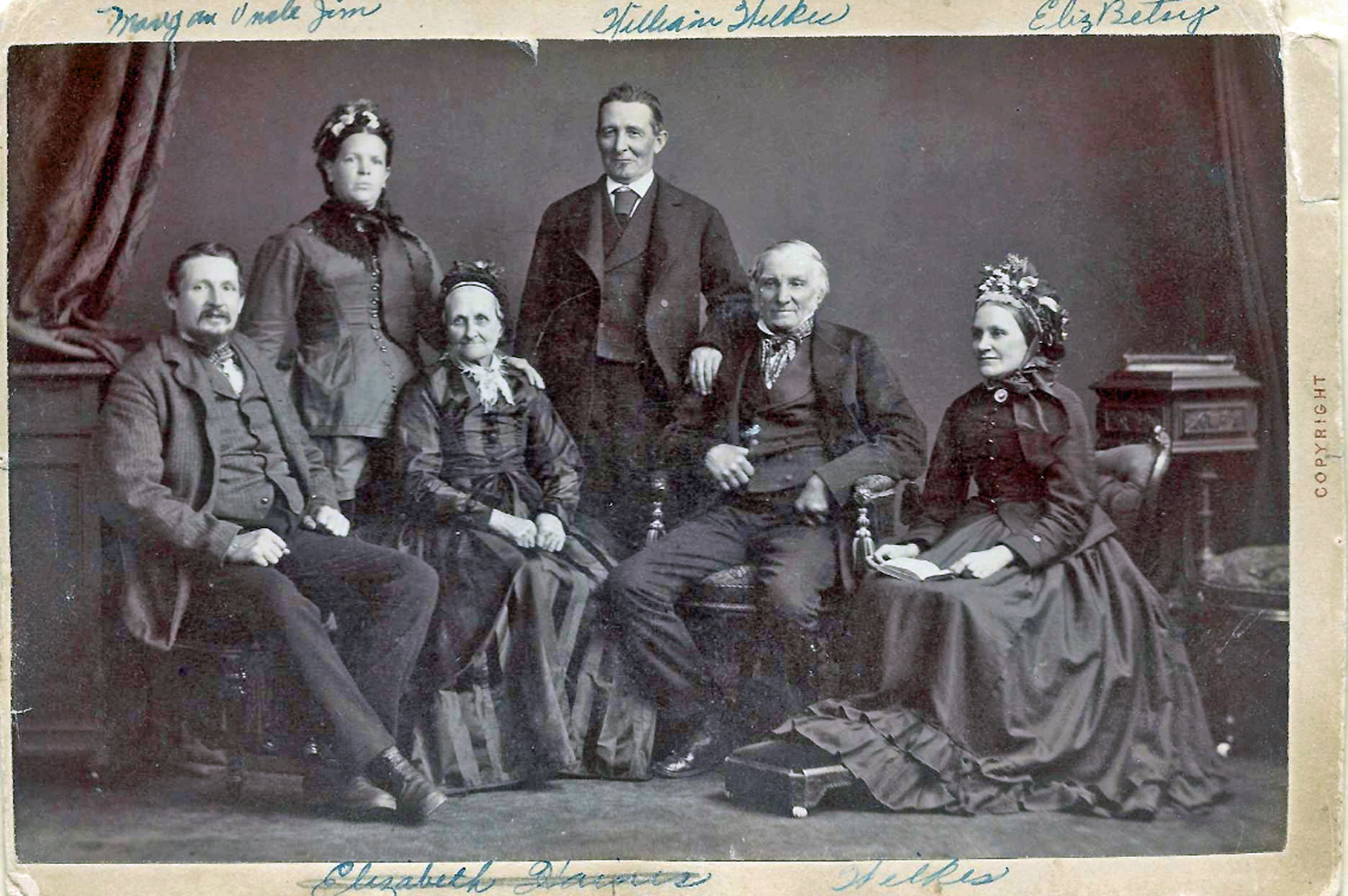 Front from left to right: James Wilkes, Elizabeth Hunt Wilkes, William Wilkes
Sr. and Elizabeth Wilkes Cleal. Back from left to right: Mary Ann Wilkes and
William Wilkes Jr. William Jr. immigrated to the United States in 1855. He was set apart as a missionary to England 1 May 1879 and released 30 April 1880, then returned to Idaho. This picture was probably taken while he was on his mission.
Front from left to right: James Wilkes, Elizabeth Hunt Wilkes, William Wilkes
Sr. and Elizabeth Wilkes Cleal. Back from left to right: Mary Ann Wilkes and
William Wilkes Jr. William Jr. immigrated to the United States in 1855. He was set apart as a missionary to England 1 May 1879 and released 30 April 1880, then returned to Idaho. This picture was probably taken while he was on his mission.
On the 3rd day of February 1930, this writer took a snapshot of the their tombstone located in the Tewkesbury Abbey churchyard along one of the pathways not too far from the front door. I had been aware that my family predecessors had lived in the city, however, I was not aware a tombstone existed.
What a thrill! My second great grandparents, William Wilkes Sr., and Elizabeth Hunt, with their daughter, Mary Ann, ages 83, 84 and 57 respectively, at the time of their burials which were quite close, date wise. Elizabeth was the first of the three in Dec 1885, he in Feb. of 1886, and daughter in March of 1886. All three buried in the same grave. Could this have been the result of an epidemic? We don't know.
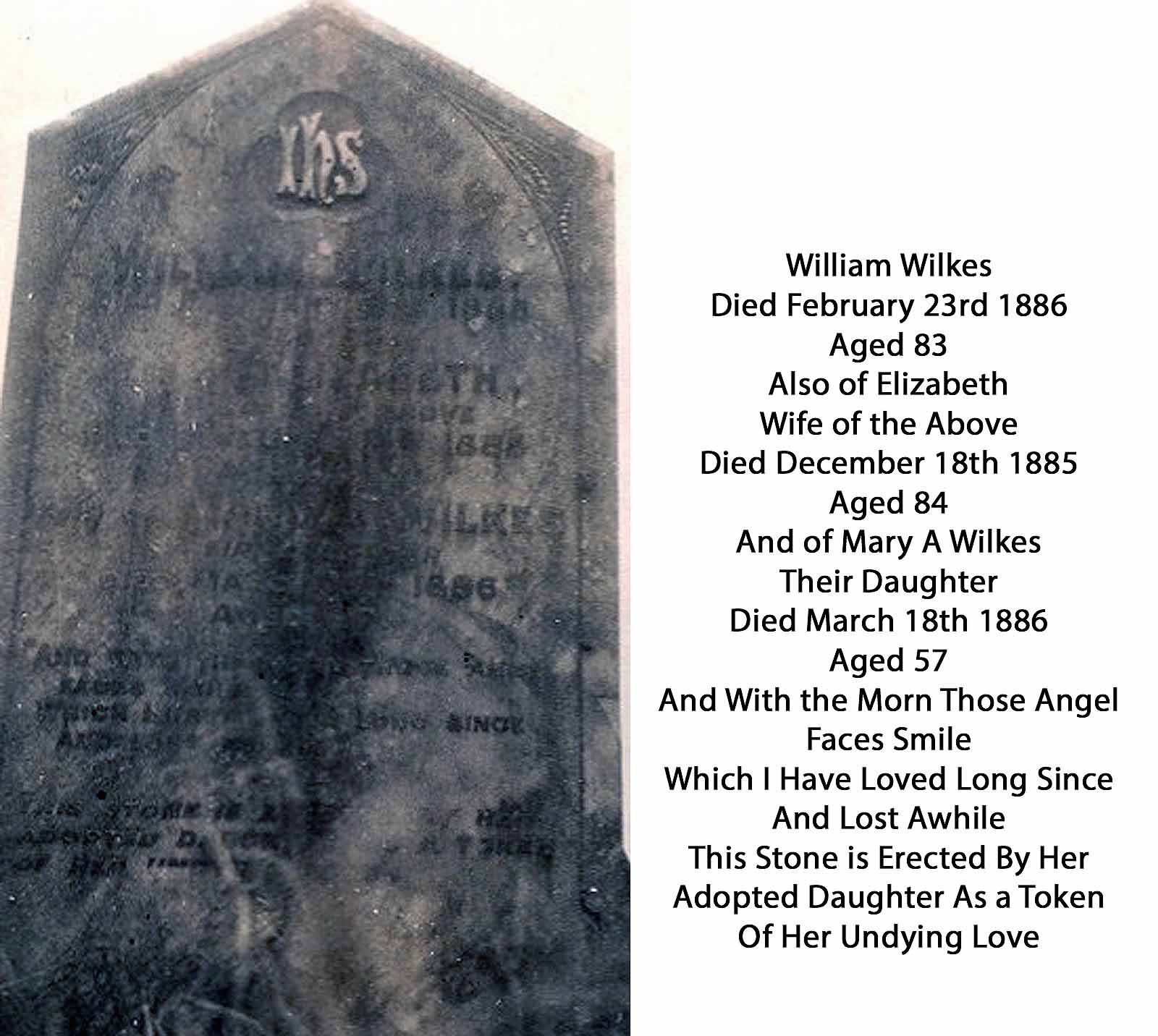 The tombstone of Mary Ann, Elizabeth and William Wilkes in the Tewkesbury Abbey grave yard.
The tombstone of Mary Ann, Elizabeth and William Wilkes in the Tewkesbury Abbey grave yard.
The IHS monogram is an ancient Christian symbol representing Jesus Christ. During the Middle Ages the name of Jesus was written IHESUS. This monogram appears on many headstones in the Christian world.
From Chart 3, we see that William Wilkes, a son of William Wilkes and Elizabeth Hunt, now becomes our next descending ancestor. He was born 25 April 1827 in Tewkesbury, and was subsequently christened on 6th of April 1828, when he was nearly one year of age. With his father being a stone or brick mason, we can suspect he may have been required to assist his family by also working in this trade. This seems all the more probable when we note that he is the family's oldest son.
During this period of time, the first half of the 1800s, it is not likely there was much chance for William to have had much chance for anything more than a very limited education, however, schooling opportunities were increasing in the middle or upper classes of people. Undoubtedly, he had his share of hod-carrying, as he was growing up. Circumstances may have been such that his services were required to mix mortar and carry it up to the scaffolding, where his father was placing brick or stone. He may have assisted in cutting stone, which was to be mortared into the structure of an arched bridge over a stream. Even today, we who have had an opportunity to walk along an English country road, have had occasion to view, on the spot, these relatively small, and many not so small, stone bridges. We sometimes stood in amazement as to the engineering know-how in placing the keystone at the top of the arch so as to tie in the stones coming together from the two separate abutments, in such a manner that there would be very little, if any settling of the structure. We marveled at the small structures, and proportionately marveled the more when such arches served as tresteling to carry railroad tracks across extended gaps such as streams, gullies or even rivers. We thought of members of our families participating in such construction during the early 1800s or even earlier, when our Charles and William were heading their respective generations. There is no intent to leave the impression that such construction engineering was new in their day, for it wasn't. Many evidences exist telling us that some of these bridges and other structures date back to the time of the Roman invasion of England, even centuries prior to our Charles and William. Such a statement is not to discredit the workmanship of our progenitors and others of their time. There was a lot of this type of work being done at these later periods of time of which we are referring.
As described in the last chapter, our ancestry lived through the great industrial revolution during the generations prior to Charles and William Wilkes. In reality, it was still continuing during their respective generations. Manufacturing had been pretty much centralized into the most ideal localities. These localities attracted workers from, not only nearby, but also, far away places. At first, as had been described of our John Bradley, two or three generations earlier, water transportation was developed for transporting people, but more essentially raw products of every description in order to carry on manufacturing. The distribution of manufactured products to all parts of England, as also, to foreign countries was essential. By the time of our first Charles Wilkes and wife, Elizabeth Bradley, James Watts had invented the steam-engine, which was the beginning of the end of canal waterways. This at the very time Charles and Elizabeth were having their family, of which our first Charles was the only known survivor of his parent's family. This invention was at the time several other important inventions came into being, such as the invention of the spinning jenny, which allowed one worker to look after several spinning wheels at once. As we got into the generation of our second Charles and wife, Ann King, the first practical steamboat appeared - this in 1802, and by 1804, the first locomotive engines made their appearance. These inventions now required a great increase of such products as iron and steel, which required more coal and natural gas, which was just coming into its own. Iron rails had to be laid for the locomotives, which required roadbeds to be constructed. They, in turn, required stone bridges - there has always been far more stone in rocky England than timber - so we come down to the conditions we were just previously discussing, our second William Wilkes, the mason and his wife, Elizabeth Haynes, who served as a laundress, accordingly to the census record.
Despite the great transition in industry and transportation that had taken place during those three to four generations of which we have just been referring - through the working years of the two Charleses and particularly our first William, we will have to agree that great progress was made. (we have just reached the marriage of our second William and much more will be said of him later) These generations had to have had more interest than the five or six generations prior to their time, during which there was so great a sameness throughout. However, our last Charles and our first William, found much hard labor with which to contend. Certainly the pick and shovel were still fundamental to their work. The masoner's work required the mortar, whether it be on the first level or the second, or third of a brick dwelling, to be carried on a hod on the shoulder. Bricks were still formed and fired by hand, and of course, the mortar used to bind them together was mixed by hand. The stone used for the surfacing of cobble-stone streets was gathered from the fields and the hillsides, by one-horse carts and by hand. Stone for construction purposes of all types had to be quarried from the stone-pits, and cut or chipped to proper shape and size by hammer and chisel. So much of it by hard labor, but no other way had been discovered. Undoubtedly, as young William was growing up, he assisted his father, the elder William.
Young William was christened on the 25th April 1827, and married Elizabeth Haynes a month prior to his nineteenth birthday, with she being four months older than he. Before we proceed with this young couple's mutual story, let us commence with our new Elizabeth's (Haynes or Haines) great grandfather.
During the very years that our ancestral family, John Bradley, the boatman on the Severn, and Ann Hiatt were having their daughter married to our first known Charles Wilkes, there was a young couple in Tewkesbury, whose children were growing up. This couple was John and Jane Haynes. We are aware of them having three children, the eldest, Richard, having been born 24 November 1757. Interestingly, this couple appeared to have become dissatisfied with the Church of England, for they had their children christened in the Presbyterian chapel. Then, one week following the christening of his first child and son, he, the father, had himself christened in the same chapel. Naturally, there is no information whatever as to their reason. The Presbyterian Church had constructed a chapel in Tewkesbury in 1707, but seemingly, did not start their parish register until 1752. Again, the reason is not known, but the professional researcher suggested the possibility that this non-conformist church may have taken care of their ceremonies within the Church of England chapel. There is a great possibility that this couple had other than the three children shown on the upcoming chart, however, no children show up on the Church of England records, nor in several surrounding parishes. Probate records for the area do not lead us to any further information for this family. Son, Richard, grew up and at the age of twenty - nearly twenty-one - married a girl from Tewkesbury, Elizabeth Hodges on the 2nd of September 1778 by banns.
By the time this couple's children are christened, they are apparently back in the Church of England, for it is from that source that the names of the children and dates of christening are found
The third of Richard's and Elizabeth's children and second son, William, is to become our direct ancestor. Nothing has been found of wife, Elizabeth's ancestry, not even so much as her christening, despite the fact that all nearby parishes have been searched. Here is a prime example where we must be vigilant in remaining alert to records which will make their possible appearances through the extraction program of the Church, when parish records will be microfilmed from beyond the ten to twelve mile radius of our ancestral centers. These records will eventually show up on the International Genealogical Index (IGI) which Index will be found, not only in the Salt Lake Library, but most branch libraries.
Richard's and Elizabeth's son, William, as mentioned, later became our direct ancestor by marrying Ann or Nancy Stone, and thru their daughter Elizabeth, who married our second William Wilkes. The Stone line has been difficult to determine, and required several years for the Genealogical Society to do the best they could. The Tewkesbury parish registers had six christening entries of children - five other than Elizabeth. Ann or Nancy's parents were John Stone and Ann Cossnett, who were christened in Tewkesbury when each were infants. Ann's grandparents on her father's side, were another John Stone and Sarah Nurley, who were married in Tewkesbury on the 19th of August 1755. Anne's grandparents on her mother's side were Richard Cossnett and Mary Hopkins, who were married, also in Tewkesbury, on the 8th of March 1733. The birthplaces, nor christening places, nor dates have been found for these couples, and we, as a family, now await their possible appearances as entries on the IGI.
Relative to history of the lives of these last mentioned ancestors of these two or three generations which have become our allied lines, it is not likely it would be much different than the descriptions already given of what our Wilkes and Bradley histories have been. During those generations all were very much in the same mold, despite the fact that there were numerous occupations in which they could have been engaged.
To give credit where credit is due, let it be stated that the professional genealogists and the Genealogical Society were solely responsible for the research and the forming of family units of the parents and grandparents of Elizabeth Haynes who married our younger William Wilkes, to whom, on occasion we have referred to as William Jr., to assist in the distinguishing him from his father who has often been designated as William Sr. So far as we are aware, these designations were never a part of their respective names originally.
It is to be hoped the reader will review the above paragraphs and compare the names listed with the chart on the next page. Perhaps the chart will place in mind a little better, the ascendancy of ancestral lines of Elizabeth Haynes or Haines, the writer's great-grandmother, who married William Wilkes Jr., as shown near the bottom of the chart.
We shall become better acquainted with this couple in the following chapter. It was they who joined the Mormon Church and who migrated to America with their two children, Sarah (later Allred) and John Wilkes, the writer's (and many reader's) grandfather.
